Richard reveals the story behind Where There Is Darkness and how it came to be written.
The photos on this page show some of the locations that either feature in the story or that were the blueprint for fictionalised places, such as the reservoir and the park in which the story begins.
What is the novel about?
Where There Is Darkness portrays a character chronically affected by the consequences of his involvement in a criminal act when he was a teenager. The story’s main theme is therefore about living with and confronting personal guilt, and how time and memory can alter perceptions of guilt and culpability. It is also about how we are defined by our pasts, and how an impulsive action – a ‘moment of madness’ – can have devastating consequences. My lofty aim was to write a story that examined the corrosive nature of guilt and the possibility of redemption.
“Don’t worry Tony,” Lydia said grimly. “Dave isn’t a big fan of fireworks.” (Chapter 2)
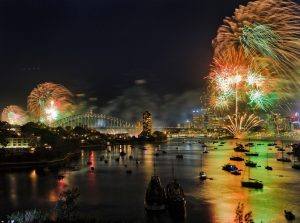
How long did it take to write?
I began writing it as a novel proper in 2007, and finished it in 2013. But around 10,000 words of the pivotal firework scene were written back in 2003. And an earlier incarnation of the main character, Dave, appeared a couple of years before then in another novel which I abandoned (because it was awful) after the first draft stage. So you could say it took between six and twelve years to write. This represents a shamefully tortoise-like performance in the production of a mere 72,000 words, but in my defence I also embarked on a new career and accumulated two children during that time, which meant the writing came second for long periods.
‘There’s a good chance here of treading on a sting ray. But I don’t tell them that.’ (Chapter 4)

Port Stephens, about two hours north of Sydney, is every bit as beautiful as it looks here.
How many drafts did you write?
Around four or five, depending how you define a draft. The first ran to 111,000 words, and the final version is 72,000. At risk of stating the obvious, much of the later work involved not so much a bit of judicious pruning as the application of a chainsaw.
‘Children breaking free of parental handholds, racing away squealing into the huge black spread of the park, down the slope towards the noise and lights.’ (Chapter 8)
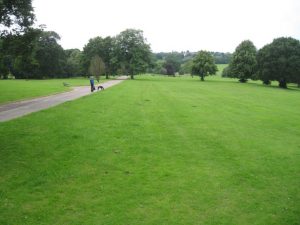
Senneley’s Park, Northfield, Birmingham. We used to go to bonfire (Guy Fawkes’) nights here in the late 1980s. Revisiting it recently for the first time since then, it seems so unlikely to me now that this benign place inspired the setting for the critical firework scenes in Where There Is Darkness.
What inspired you to write Where There Is Darkness?
Two things combined to generate the idea. Firstly, a chance encounter with an old childhood acquaintance who had just served a prison sentence for a serious assault sparked an interest in what it might be like to live, year after year, with the guilt of having done something terrible. I also began to wonder what it might be like to suffer chronic guilt brought about not by a deliberate or malicious act but as a result of stupidity, or carelessness, or even just bad luck. Can any of us truthfully say we’ve never done something reckless or stupid that were it not for the randomness of fate, might have ended in tragedy? So, I became interested in the frightening notion that one split second of random youthful stupidity can change the course of a life, or even end one.
‘The figure inside the semicircle was thrown back against the garage doors with a metallic boom. The attackers closed in and there was a flurry of shouting and angry movement.’ (Chapter 14)
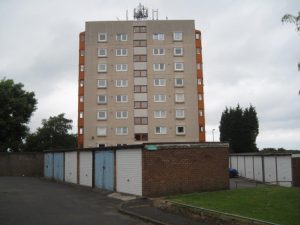
This delightful example of a Birmingham tower block and garages are in Brett Drive, Bartley Green, the street leading up to my old school.
Why did you cut almost 30 per cent from the first draft?
Because I was made to realise that it was either irrelevant to the real story (and was thus obscuring it), or consisted largely of the protagonist lounging around tediously bemoaning his fate. I have Associate Professor (and distinguished author) Debra Adelaide, my MA supervisor, largely to thank for tactfully pointing these deficiencies out to me.
‘Written in red paint on the left hand gate was: OWN UP OR DIE. The lettering on the other gate read: OWN UP AND DIE.’ (Chapter 14)
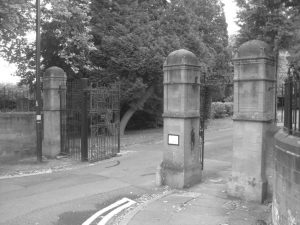
These are the entrance gates to Lodge Hill Cemetery in Selly Oak, Birmingham; they doubled in my imagination as the entrance to the park itself, as well as to the (fictional) cemetery outside which Dave waits in the penultimate scene of Where There Is Darkness.
Why is the novel called Where There Is Darkness?
While not intended to represent a social snapshot of that era, the book is partly set in Britain during the early critical years of Margaret Thatcher’s prime ministership, and the novel’s title is a rather oblique acknowledgement of the Thatcher political subtext. ‘Where there is darkness’ is an extract from a St Francis of Assisi poem that was paraphrased by Margaret Thatcher in an era-defining (and now somewhat notorious) speech she made on being elected Prime Minister in May 1979.
The novel’s title is also suggestive of the darkness within the soul and of the notion that living with chronic guilt imbues a kind of myopia, an inability to see things and function properly. A sense of loss. The fallibility of memory. This motif of sight impairment runs right through the story.
Finally, the title reflects that the pivotal crime (and much of its aftermath) literally takes place in the, er, dark.
“Is that Bournville Lane Police Station?”
“It was last time I looked. What d’you want, son?” (Chapter 14)
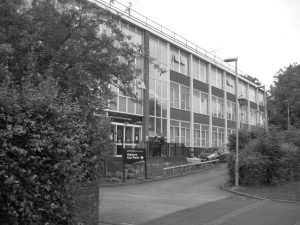
Why did you adopt a first person narrative voice?
In the early drafts I wrote the narrative in Dave’s (the protagonist’s) third person point of view. This seemed to work well for the sections of the story set in 1981. But when I began to write the present day scenes, where his memories start to crystallise and he begins to understand past events, the third person seemed too distant. I wanted the reader to be not just inside Dave’s head, but to experience the guilt exactly as Dave did. So I switched to first person – admittedly a rather more traditional choice for a protagonist who is guilty of a crime.
‘Now the trees were black and silent. Nothing was visible behind them except a few dim rectangles of light from a couple of distant tower blocks.’ (Chapter 14)
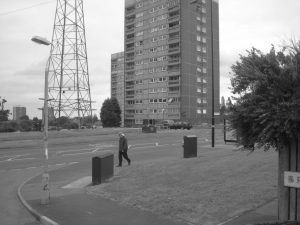
Who are your favourite authors?
My favourite authors – and whom I can’t deny have influenced my own writing – include Ian McEwan, Jonathan Franzen, Sebastian Faulks and Julian Barnes. I’m not much of a one for verbal fireworks; I prefer the clean, visceral prose of these masters and their ability (especially McEwan) to render sinister undertones to the mundane everyday world.
‘As always we avoided the bleak concrete of the Bull Ring shopping centre. I was terrified of the place.’ (Chapter 15)
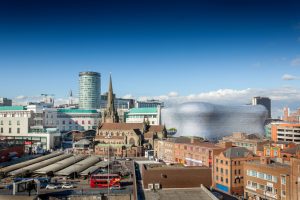
Bleak no more: the new Bull Ring centre is a futuristic miracle of blurred silver steel. It even has a Selfridge’s store. Take that, London.
‘We stood on the footbridge over the dual carriageway, leaning on the wet railings, watching the cars and double-decker buses slide past beneath.’ (Chapter 15)
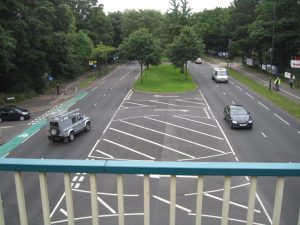
Bristol Road footbridge, Bournville, Birmingham. Like Pete and Dave, my teenage friends and I often leant on the railing and dared each other to leap, James Bond style, onto the roof of a passing bus. Luckily we were all talk and no action.
Did you do much research?
No, and much of what I did I ended up not using. I got very interested in the early North Sea Oil industry and got carried away accumulating information about it – but then discarded most of it. I interviewed a doctor and a police officer, but that was all. Everything else was already there in my head as a random jumble of ideas, memories and half-formed scenes.
‘We took the shorter route home along the canal towpath, past the glassy black water and the frost-shattered red bricks lining the banks. The fog hung over the canal and turned from white to grey in the dusk, a few streetlamps showing through in haloes of dull yellow light.’ (Chapter 16)
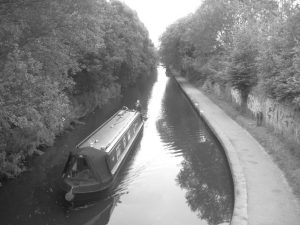
The Birmingham and Worcester Canal (above) where it passes under the Bristol Road, Selly Oak, Birmingham.
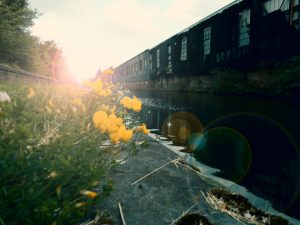
Birmingham has more miles of canal than Venice. No gondolas though, strangely.
How did you tackle the writing of dialogue – particularly the Birmingham accent?
Accurately representing the local regional dialect was a big challenge. I wanted it to be at least suggestive of the ‘Brummie’ accent of my home town but without emulating the precisely phonetic styles of authors like Roddy Doyle or Irvine Welsh, which I think can be tiresome for the reader. In the end I tried to use carefully chosen words I hoped would convey the rhythm and flavour of the Birmingham dialect without clogging things up with endless apostrophes, dropped g’s, and mangled vowel constructions. Alroight?
‘Nowhere had ever seemed so welcoming as the Gun Barrels pub that night as I came skating back from the Bristol Road bus stop with five pints of lager and two rum and cokes inside me.’ (Chapter 17).
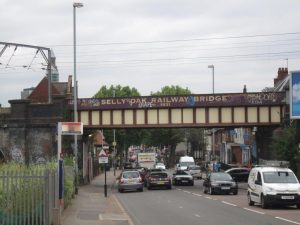
The Bristol Road, Selly Oak, Birmingham. The Dog & Partridge pub (Chapter 20) was behind the camera on the right; The Gun Barrels was about half a mile down on the left. Both were demolished a few years ago. The Dog & Partridge had a reputation as something of a den of thieves; whether this was true or not, it was a place best avoided. It was always in my mind as the blueprint for Tony’s local, The Bulldog.
Why did you set much of the novel in 1981 Birmingham?
‘Place’ is about more than just physical location. Places can at different times have very different characteristics and atmospheres depending on the historical context and the sociological and political climate of the time. Part of the reason I set the crimes of my protagonist in 1981 was that this was a time of profound social and political upheaval in Britain. Inner city riots erupted across the country in the summer of that year. Unemployment passed three million. It was a time characterised by crime, social unrest and youth disenfranchisement. (I remember very well the riots in Brixton, Liverpool, Bristol and elsewhere in the summer of 1981, and a repeat across the country in 1985 when Handsworth in Birmingham went up in flames.)
My home town is a hugely underrated and often maligned place. Few other novels have been set there, and those that have – including the good ones – have in my view not quite represented what it was really like to grow up there in the 1970s and 80s – or at least, as my experience was. So perhaps I wanted to set the record straight, if only for myself.
‘As kids we thought the reservoir was bottomless, like Loch Ness. A place where crimes and secrets could be swallowed forever.’ (Chapter 19)
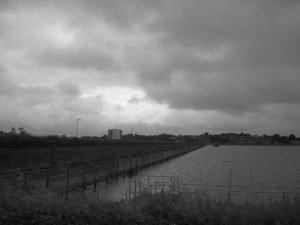
The photo above shows the dam at the northern end of Bartley Reservoir, Birmingham, a fictionalised version of which appears in the story. The one below shows ‘the rezzer’ viewed from Frankley Beeches hilltop, with the city skyline in the distance.
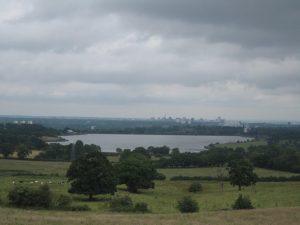
How important were your own memories in recreating the urban Britain of 35 years ago?
It was only in writing the later drafts that I came to realise that Where There Is Darkness, spanning thirty years, was really a story about memory. The firework accident and its immediate aftermath are important, but the story is primarily about how Dave buries his guilt, and how this dormant guilt affects his life, and how the guilt re-emerges when he returns to the place where it originated.
I am drawn to the notion that time both erodes and sustains memory, so that some events fade or distort whereas others, perhaps deeply-buried, can resurface or even become more vivid. Having lived in sunny Australia for over two decades, in writing Where There Is Darkness I had to rely entirely on my distant memories of an urban British winter. (The extent to which I’ve succeeded in evoking that far-off place is for others to say.)
In a parallel (and I admit, not the only one) between my life and my novel’s protagonist’s, I’ve come to see that in the same way as certain places and events have been ingrained into my own memories and have even become more powerful over the years, my character Dave, once his dormant guilty memories are triggered, has greater recall after three decades have passed than he ever did at the time.
‘All I can do is nod, and look at the river, and try to keep it all in.’ (Chapter 22)
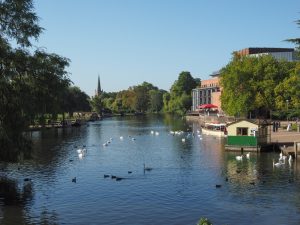
The river Avon in Stratford, viewed from the old stone footbridge. The Royal Shakespeare Theatre is on the right and the spire of the Holy Trinity Church, where Shakespeare is buried, is in the distance.
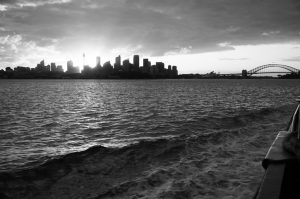
“Australia!” he says. “It’s all just desert, isn’t it, and dangerous animals an’ stuff?” (Chapter 24)